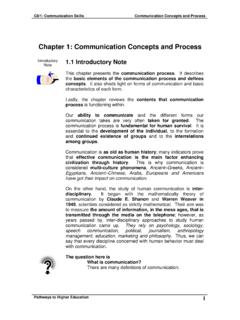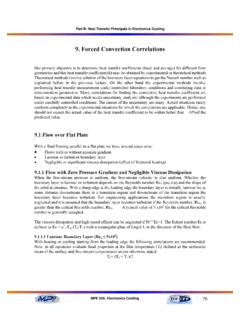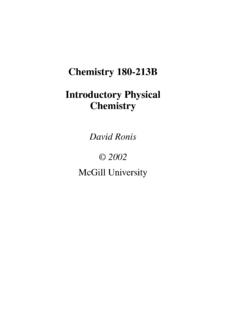Transcription of 10. Radiation Heat Transfer - cu
1 Part B: heat Transfer Principals in Electronics Cooling 98 MPE 635: Electronics Cooling 10. Radiation heat Transfer Introduction Radiation heat Transfer plays a major role in the cooling of electronics. As well as conduction and convection heat Transfer , Radiation is an equally important mode. Also the thermal Radiation has many applications such as engine cooling, furnaces, boilers, piping and solar Radiation . The thermal Radiation transferred by electromagnetic waves, called photons, is emitted by bodies due to temperature differences. All surfaces continuously emit and absorb radiative energy by lowering or raising their molecular energy levels. The electromagnetic waves travel through any medium or in vacuum at the speed of light (c), which equals 3 108 m/s. this speed equal to the product of the wave length and frequency c = The metric unit for the wave length is centimeters or angstroms (1 angstrom = 10-8 centimeter).
2 A portion of the electromagnetic spectrum is shown in Figure 10-510-410-310-210-1110102103104Ga mma ra y sX raysu lt ra v io le tTh e rma l ra d iat io nIn fraredMicrowaveRedyellowBlu eGre e nVis ib le ( m) Figure Electromagnetic spectrum Blackbody Radiation Materials used in electronic hard ware may be classified as black or gray surfaces. The ideal surface is known as a blackbody or black surface, since it absorbs or emits 100% of the all incoming Radiation . A rough surface has higher emittance than the same surface when it is smooth. Also, a finned surface has a higher emittance than does the same surface without fins. In both cases the emittance increases because the surfaces have many small cavities. These cavities act as many small partial black bodies. For example a small hole in a hollow sphere is often used to represent a black body.
3 The energy enters the small opening and strikes the opposite wall, where part of the energy is absorbed and part is reflected. The reflected energy again strikes the opposite wall, where part of the energy is absorbed and part is Part B: heat Transfer Principals in Electronics Cooling 99 MPE 635: Electronics Cooling reflected. This process continues until all of the energy is absorbed, as shown in The total amount of radiative energy emitted from a surface into all directions above it is termed emissive power; we distinguish between spectral (at a given wavelength , per unit wavelength and per unit surface area) and total (encompassing all wavelengths) emissive power. The magnitude of emissive power depends on wavelength , temperature T, and a surface property, called emissivity , which relates the ability of a surface to emit radiative energy to that of an ideal surface, which emits the maximum possible energy (at a given wavelength and temperature).
4 The spectral distribution of the emissive power E ,b of a black surface is given by Planck s law is of the form ]1[)/(51,2 =TCbeCE Where the Radiation constants or some times called Planck function constants are C1= x108 W. m4/m2 and C2= x104 The total emissive power Eb of a blackbody is given by Stefan-Boltzmann law. Expressed as ,0bbEEd = Integration yields; Eb = T4 Where the temperatures in the Kelvin's and the Stefan-Boltzmann constant ( ) has the numerical value = x 10-8 Figure Constructing a black body enclosure Figure shows the spectral emissive power E ,b as a function of temperature and wavelength, the maximum E ,b is corresponding to wave length max which depends on surface temperature. The nature of this dependence may be obtained by differentiating the Equation with respect to and setting the result equal to zero, we obtain max T = The Equation is known as Wien's displacement law.
5 ( )( )( )Part B: heat Transfer Principals in Electronics Cooling 100 MPE 635: Electronics Cooling Figure Spectral emissive power bE, as a function of temperature and wavelength Radiation Properties of Surfaces When radiant energy strikes a material surface as shown in Figure , part of this Radiation is reflected, part is absorbed, and part is transmitted. So that Radiation properties are defined: Reflectivity Radiation incoming totalradiation incoming ofpart reflected= Absorptivity Radiation incoming totalradiation incoming ofpart absorbed= Transmissivity Radiation incoming totalradiation incoming ofpart dtransmitte= Emissivity re temperatusameat surfaceblack aby emittedenergy surface a from emittedenergy = The emissivities of clean metallic materials are generally very low while the emissivities of nonmetallic materials are much higher.
6 Typical emissivity values for various materials are shown in Table That emissivity is a surface phenomenon can be demonstrated by placing a thin coat of paint on a highly polished metal surface. Before painting a polished copper surface, the emissivity will be about However, with just a thin coat of lacquer, cm thick, the emissivity of the same surface will increase sharply to about Part B: heat Transfer Principals in Electronics Cooling 101 MPE 635: Electronics Cooling AbsorptionIncident radiationReflectionTransmission Figure Reflection, absorption, and transmission Since all Radiation striking a body must be reflected, absorbed, or transmitted, it follows that 1 In some practical applications surface layers are thick enough to be opaque then the transmissivity may be taken as zero. All four properties may be functions of wavelength, temperature, incoming direction (except emissivity), and outgoing direction (except absorptivity).
7 Table Typical emissivities at 100 oC Material Emissivity Aluminum 6 Commercial sheet Rough polish Gold, highly polished Steel, polished Iron, polished 0. Cast iron, machine cut Brass, polished Copper, polished Polished steel casting Glass, smooth Aluminum oxide Anodized aluminum Black shiny lacquer on iron Black or white lacquer Aluminum paint and lacquer Rubber.
8 Hard or soft ( )Part B: heat Transfer Principals in Electronics Cooling 102 MPE 635: Electronics Cooling Two types of reflection phenomena may be observed when Radiation strikes a surface. The reflection is called specular if the angle of incidence is equal to the angle of reflection as shown in Figure (a), the reflection is called diffuse when the incident beam is distributed uniformly in all directions after reflection as shown in Figure (b).No real surface is either specular or diffuse. An ordinary mirror is quite specular for visible light, but would not necessarily be specular over the entire wave length range of thermal Radiation . Ordinarily, a rough surface exhibits diffuse behavior better than polished surface. Similarly, a polished surface is more specular than a rough surface.
9 SourceReflected ray s SourceReflected(a)(b) Figure (a) Specular reflection (b) Diffuse reflection Kirchhoff's Law Assume that a perfectly black enclosure is available, , one which absorbs all the incident Radiation falling upon it, as shown in ABlack enclosureqi Bo d yE Model used for deriving Kirchhoff's law This enclosure will also emit Radiation according to the T4 law. The radiant flux arriving at a given area inside the enclosure is qi W/m2. Now suppose that a body is placed inside the enclosure until it reaches equilibrium. At equilibrium the energy absorbed must be equal to the energy emitted. The Radiation absorbed by the body = qi A The Radiation emitted from the body = EA At equilibrium EA = qi A If the body is replaced by a black body ( =1) with the same area and shape and allowed to equilibrium at the same temperature.
10 Eb A = qiA ( )( )Part B: heat Transfer Principals in Electronics Cooling 103 MPE 635: Electronics Cooling If the Equation is divided by Equation it yields = E / Eb This ratio is the emissive power of a body to the emissive power of a black body at same temperature. It is also defined before as the emissivity( ) of the body. So that, for any surface inside enclosure = E / Eb = The Equation is called Kirchhoff's law. Radiation between Black Surfaces and Shape Factors The shape factor Fij is the fraction of radiant energy leaving one surface that is intercepted by another surface; other names for the shape factor are view factor, angle factor, and geometrical factor. To develop a general expression for Fij, consider two black surfaces has A1 and A2 as shown in Figure the two surfaces are maintained at different temperature we want to determine the amount of energy which leaves one surface to another.








